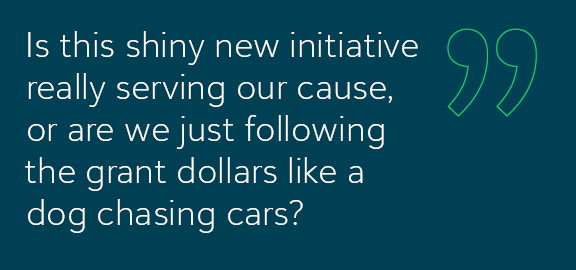Restrict to Expand: Why Saying “No” Is Your Nonprofit’s Secret Growth Engine

But here’s the twist that makes many in the finance department flinch: real growth starts with boundaries.
Especially in this year’s delightfully unpredictable financial and operational landscape, you may be staring down a budget cycle that feels more restrictive than expansive. And that’s okay, because you don’t need expansion to grow. You need focus.
True growth begins when you channel your inner minimalist and say goodbye to anything that doesn’t spark mission outcomes. Intentional restriction. Yes, choosing not to do certain things can be the key to unlocking meaningful mission growth.
By doubling down on what matters, reinforcing your core capabilities, and aligning financial decisions with your highest priorities, you create a launchpad for future expansion that’s scalable, sustainable, and less chaotic.
Mission First: Why Restriction Is the Hero You Didn’t Ask For
Being a realist, traditional budgeting often ends in doom-and-gloom PowerPoint decks with more red than anyone wants to see. But stepping back and asking, “What actually drives our mission?” can be strangely freeing. It turns out, growth without focus is just fragility in disguise.
When thinking about budgeting, you have to ask yourself:
- Just because we can grow, should we?
- Is this shiny new initiative really serving our cause, or are we just following the grant dollars like a dog chasing cars?

As you diversify programs and funding sources, it’s easy to lose sight of your core purpose. And when you’re pressured to say “yes” to every opportunity, you risk diluting your impact and throwing off the organizational GPS. Stopping to examine what the organization’s mission and core values are can be like pulling out a compass and finding due north again.
You don’t restrict your focus to freeze, but to sharpen. Ask the hard stuff:
- Which programs actually move the needle for your mission?
- Are you funding impact or inertia? What drives the funders that you know you can rely on?
- If all your funding vanished tomorrow (please don’t), what would you prioritize in your rebuild?
This isn’t some breezy whiteboard exercise. It’s trench-work painful, illuminating, and ultimately game-changing. By channeling limited resources into top-priority activities, you cement organizational identity and trust. And once your core is strong and focused? Then you can think about expanding into new mission areas with actual intention, not just good vibes.
Disciplined Planning: Sources, Uses, and Saying “No” Like a Pro
Intentional restriction isn’t about being a wet blanket. It’s about clarity. Clarity starts with a disciplined “sources and uses” framework.
Sources: Map every dollar, label its terms, and ask whether this fund supports our actual work, or are we reshaping our programs to fit the funding? You may need to say “no” to funds that drag you off-course. It’s like declining a second donut—the jelly-filled goodness sounds delicious now, but you know you’ll regret it later.
Uses: Direct expenditures toward what matters most. That new initiative with 14 emojis in the title might be fun, but if it’s not advancing your mission, park it until the foundation is solid.
Here’s what this disciplined approach gets you:
- Protection for your core programs when things go sideways (and they will)
- A spotlight on bloated or underperforming areas that are dragging you down (or, quite frankly, that other organizations can do better)
- Breathing room to expand the right way, when the timing and resources align
Remember that restriction doesn’t mean slash-and-burn. Your staff still needs tools, systems, and snacks (seriously, snacks matter). Cutting budgets doesn’t mean cutting humanity. Make sure your team feels equipped, not abandoned.
Flex Your Budget: Controlled Expansion for the Win
You’ve stabilized your foundation. You’ve reinforced the essentials. Now what? Expansion, but with guardrails.
You need a budget structure that’s as modular as a Lego set and twice as fun:
- Base Budget: Covers your mission’s daily heartbeat
- Expansion Tier: Initiatives that only launch if new funds come through
- Contingency Layer: Your “we didn’t plan for that, but we’re still standing” buffer
This gives you flexibility and credibility. And internally, it allows you to avoid knee-jerk decisions like hiring three new staff based on a single good month of donations.
When new opportunities arise:
- Pilot, don’t plunge.
- Restrict the scope.
- Expand after success is proven and funded.
Controlled expansion feels slower, but that’s where resilience lives. You’re not just scaling. You’re scaling smart.
Expansion Is Not a Straight Line—It’s Chutes and Ladders
Expansion isn’t linear. It’s more like nonprofit chutes and ladders. You climb, you slide, and occasionally you land on a surprise audit or funding crisis square. But by restricting to reinforce and expanding from that position of strength, you give your organization the best chance at real impact. The kind of growth that doesn’t just look good on paper but also transforms communities.
Want to learn more about restricting to expand your organization? Check out the webinar, Restricting to Expand: How Sharpening Your Vision Fuels Stratospheric Growth.


